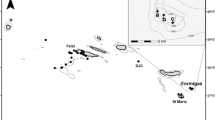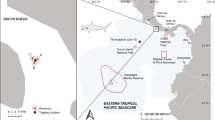Abstract
The white-streaked grouper (Epinephelus ongus) is an important fisheries target in the region around Okinawa. This species forms spawning aggregations at specific spawning grounds in the last-quarter of the moon in April and/or May. Using a tag-and-release method, we estimated the migration distance and the degree of unified movement of groupers associated with the spawning migration. In total, 1157 E. ongus individuals were tagged and released at their home grounds in the non-spawning period and 350 were tagged at a known spawning ground (Yonara Channel) in the spawning period. For the fish that were released at the home grounds, 23 individuals were recaptured at the spawning ground during in the spawning periods. For the individuals that were released at the spawning ground, six individuals were recaptured outside of the spawning ground. The estimated migration distances from the home ground to the spawning ground ranged from 2.2 to 8.8 km. There was no significant relationship between the fish total length (TL) and migration distance for both males and females. Tagged individuals inhabiting the same home ground were recaptured at different points at the spawning ground separated by a distance of over several hundred meters. Furthermore, tagged individuals that were released at the same point at the spawning ground were recaptured at different home grounds separated by a distance up to several kilometers. These results suggest that unified movements associated with the spawning migration are not high for E. ongus, which is contradict with some previous studies suggesting the coordinated spawning migration of other Epinephelus spp.







Similar content being viewed by others
References
Beets J, Friedlander A (1992) Stock analysis and management strategies for red hind, Epinephelus guttatus, in the U.S. Virgin Islands. Proc Gulf Caribb Fish Inst 42:66–79
Beets J, Friedlander A (1999) Evaluation of a conservation strategy: a spawning aggregation closure for red hind, Epinephelus guttatus, in the U.S. Virgin Islands. Environ Biol Fish 55:91–98
Bolden SK (2000) Long-distance movement of a Nassau grouper (Epinephelus striatus) to a spawning aggregation in the central Bahamas. Fish Bull 98:642–645
Claydon J (2004) Spawning aggregations of coral reef fishes: characteristics, hypotheses, threats and management. Oceanogr Mar Biol Annu Rev 42:265–302
Colin PL, Sadovy YJ, Domeier ML (2003) Manual for the study and conservation of reef fish spawning aggregations. Society for the conservation of reef fish aggregations, Special Publication No. 1 (ver. 1), pp 1–98 + iii
Domeier ML, Colin PL (1997) Tropical reef fish spawning aggregations: defined and reviewed. Bull Mar Sci 60:698–726
Domeier ML (2012) Revisiting spawning aggregations: definitions and challenges. In: Sadovy de Mitcheson Y, Colin PL (eds) Reef fish spawning aggregations: biology, research and management. Springer, London, pp 1–20
Hamilton R, Sadovy de Mitcheson Y, Aguilar-Perera A (2012) The role of local ecological knowledge in the conservation and management of reef fish spawning aggregations. In: Sadovy de Mitcheson Y, Colin PL (eds) Reef fish spawning aggregations: biology, research and management. Springer, London, pp 331–369
Johannes RE, Squire L, Graham T, Sadovy Y, Renguul H (1999) Spawning aggregations of groupers (Serranidae) in Palau. Marine Conservation Research Series Publ. 1, The Nature Conservancy. 144 pp
Kadison E, Nemeth RS, Blondeau JE (2009) Assessment of an unprotected red hind (Epinephelus guttatus) spawning aggregation on Saba Bank in the Netherlands Antilles. Bull Mar Sci 85:101–118
Levin PS, Grimes CB (2002) Reef fish ecology and grouper conservation and management. In: Sale PF (ed) Coral reef fishes. Academic, San Diego, pp 377–389
Luckhurst BE (1998) Site fidelity and return migration of tagged red hind (Epinephelus guttatus) to a spawning aggregation site in Bermuda. Proc Gulf Caribb Fish Inst 50:750–763
Nanami A, Sato T, Ohta I, Akita Y, Suzuki N (2013a) Preliminary observations of spawning behavior of white-streaked grouper (Epinephelus ongus) in an Okinawan coral reef. Ichthyol Res 60:380–385
Nanami A, Sato T, Takebe T, Teruya K, Soyano K (2013b) Microhabitat association in white-streaked grouper Epinephelus ongus: importance of Acropora spp. Mar Biol 160:1511–1517
Nanami A, Kawabata Y, Sato T, Yamaguchi T, Kawabe R, Soyano K (2014) Spawning migration and returning behavior of white-streaked grouper Epinephelus ongus determined by acoustic telemetry. Mar Biol 161:669–680
Nemeth RS (2005) Population characteristics of a recovering US Virgin Islands red hind spawning aggregation following protection. Mar Ecol Prog Ser 286:81–97
Nemeth RS, Blondeau J, Herzlieb S, Kadison E (2007) Spatial and temporal patterns of movement and migration at spawning aggregations of red hind, Epinephelus guttatus, in the U.S. Virgin Islands. Environ Biol Fish 78:365–381
Nemeth RS (2009) Dynamics of reef fish and decapod crustacean spawning aggregations: underlying mechanisms, habitat linkages, and trophic interactions. In: Nagelkerken I (ed) Ecological connectivity among tropical coastal ecosystems. Springer, pp 73–134
Ohta I (2007) Current status of coral reef fish fisheries in the Yaeyama Islands. Annu Rep Okinawa Prefectural Fish Ocean Res Cent 68:189–196 (in Japanese)
Ohta I, Ebisawa A (2009) Relationship of forming spawning aggregation of the white-streaked grouper, Epinephelus ongus, with lunar periodicity and water temperature in Yaeyama Islands. Annual Report of Okinawa Prefectural Fisheries and Ocean Research Center 70:28–35 (in Japanese)
Ohta I, Nanami A (2009) Distribution of the white-streaked grouper, Epinephelus ongus, in the spawning ground in Yaeyama Islands. Annual Report of Okinawa Prefectural Fisheries and Ocean Research Center 70:36–39 (in Japanese)
Randall JE (1987) A preliminary synopsis of the groupers (Perciformes: Serranidae: Epinephelinae) of the Indo-Pacific Region. In: Polovina JJ, Ralston S (eds) Tropical snapper and groupers: biology and fisheries management. Westview Press, Boulder, pp 89–188
Rhodes KL, Sadovy Y (2002) Temporal and spatial trends in spawning aggregations of camouflage grouper, Epinephelus polyphekaidon, in Pohnpei, Micronesia. Environ Biol Fish 63:27–39
Rhodes KL, Tupper MH (2008) The vulnerability of reproductively active squaretail coral grouper (Plectropomus areolatus) to fishing. Fish Bull 106:194–203
Robinson J, Aumeeruddy R, Jörgensen TL, Öhman MC (2008) Dynamics of camouflage (Epinephelus polyphekadion) and brown marbled grouper (Epinephelus fuscoguttatus) spawning aggregations at a remote reef site, Seychelles. Bull Mar Sci 83:415–431
Russ GR (2002) Yet another review of marine reserves as reef fishery management tools. In: Sale PF (ed) Coral reef fishes: dynamics and diversity in a complex ecosystem. Academic, San Diego, pp 421–443
Sadovy Y (1996) Reproduction of reef fishes. In: Polunin NVC, Roberts CM (eds) Reef fisheries. Chapman and Hall, London, pp 15–59
Sadovy Y, Domeier M (2005) Are aggregation-fisheries sustainable? Reef fish fisheries as a case study. Coral Reefs 24:254–262
Sadovy Y, Rosario A, Roman A (1994) Reproduction in an aggregating grouper, the red hind, Epinephelus guttatus. Environ Biol Fish 41:269–286
Sadovy Y, Cornish A, Domeier M, Colin PL, Russell M, Lindeman KC (2008) A global baseline for spawning aggregations of reef fishes. Conserv Biol 22:1233–1244
Sadovy de Mitcheson Y, Craig MT, Bertoncini AA, Carpenter KE, Cheung WWL, Choat JH, Cornish AS, Fennessy ST, Ferreira BP, Heemstra PC, Liu M, Myers RF, Pollard DA, Rhodes KL, Rocha LA, Russell BC, Samoilys MA, Sanciangco J (2013) Fishing groupers towards extinction: a global assessment of threats and extinction risks in a billion dollar fishery. Fish Fish 14:119–136
Sadovy de Mitcheson Y, Erisman B (2012) Fishery and biological implications of fishing spawning aggregations, and the social and economic importance of aggregating fishes. In: Sadovy de Mitcheson Y, Colin PL (eds) Reef fish spawning aggregations: biology, research and management. Springer, London, pp 225–284
Sala E, Ballesteros E, Starr RM (2001) Rapid decline of Nassau grouper spawning aggregations in Belize: fishery management and conservation needs. Fisheries 26:23–30
Samoilys MA (1997) Periodicity of spawning aggregations of coral trout Plectropomus leopardus (Pisces: Serranidae) on the northern Great Barrier Reef. Mar Ecol Prog Ser 160:149–159
Shapiro DY (1987) Reproduction in groupers. In: Polovina JJ, Ralston S (eds) Tropical snapper and groupers: biology and fisheries management. Westview Press, Boulder, pp 295–327
Starr RM, Sala E, Ballestreros E, Zabala M (2007) Spatial dynamics of the Nassau grouper Epinephelus striatus in a Caribbean atoll. Mar Ecol Prog Ser 343:239–249
Zeller DC (1997) Home range and activity patterns of the coral trout Plectropomus leopardus (Serranidae). Mar Ecol Prog Ser 154:65–77
Zeller DC (1998) Spawning aggregations: patterns of movement of the coral trout Plectropomus leopardus (Serranidae) as determined by ultrasonic telemetry. Mar Ecol Prog Ser 162:253–263
Acknowledgments
We express our grateful thanks to K. Kinjo for his assistance in field surveys and especially for his field guiding and piloting of the research boat, T. Yogi, A. Yano, S. Arakaki, Y. Fukuda, G. Suzuki, Y. Kawabata, H. Yamashita and Y. Akita for their assistance with tagging and/or capturing tagged fishes, S. Mamiya for laboratory work and the staff of Research Center of Sub-tropical Fisheries, Seikai National Fisheries Research Institute, for support during the present study. Constructive comments on the manuscript from C.P. Norman were much appreciated. We also thank the fishermen and staff of Yaeyama Fishermen’s Cooperative Association for their kind provision of the recaptured fishes. The present study complies with current laws in Japan.
Author information
Authors and Affiliations
Corresponding author
Rights and permissions
About this article
Cite this article
Nanami, A., Ohta, I. & Sato, T. Estimation of spawning migration distance of the white-streaked grouper (Epinephelus ongus) in an Okinawan coral reef system using conventional tag-and-release. Environ Biol Fish 98, 1387–1397 (2015). https://doi.org/10.1007/s10641-014-0366-0
Received:
Accepted:
Published:
Issue Date:
DOI: https://doi.org/10.1007/s10641-014-0366-0




